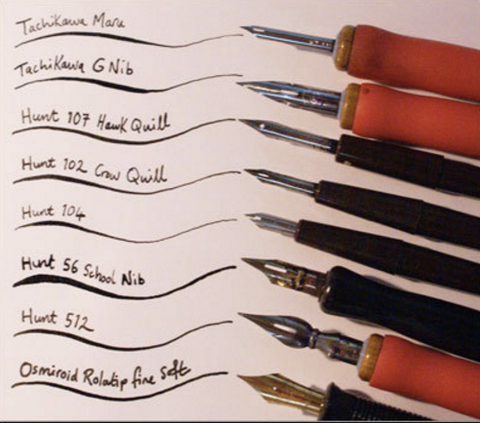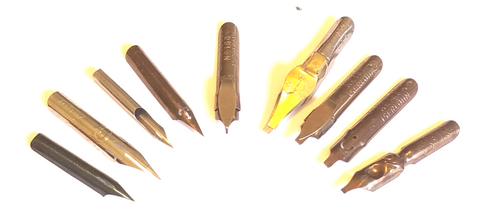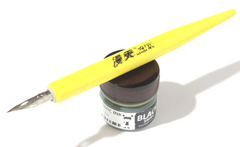About Dip Nibs
Dip nibs are old fashioned pen nibs used by artists, calligraphers, and scribblers who enjoy the special qualities they provide. Dip nibs are sold separately from a pen. They are often sold in bulk, say, ten nibs to a box. Dip nibs are traditionally inserted into holders or "sticks" that are then used like pens.
<
People who use dip pen nibs usually have their favorites. Dip nibs are designed to provide a specific type of line or range of lines that the artist is trying to use to create an artistic effect.
A Wide Variety of Dip Pen Nibs
There is a wide variety of dip pen nibs, so we can't list them all. Most popular dip nibs fall into two categories: broad point and pointed. The name refers to the tip of the nib. Nibs with broad tips are used for lettering with thick lines and drawing swaths. Nibs with pointed tips are used to draw thinner lines and thin line with varying thickness. You can see the difference in the tip shapes below.

The five nibs on the left are pointed nibs. The four nibs on the right are vbroad or chisel nibs.
Dip Nibs Are Not Tipped
Dip nibs are not tipped, which means there is no ball on the end of the nib that lets you move the nib in any direction and keeps the tip from wearing down or catching on paper. You can see this in the image below.

The dip nib on the left has not been tipped, so it comes to a sharp point. The fountain pen nib on the right has been tipped. You can see the "ball" clearly on the underside of the nib.
Most fountain pen nibs are designed for writing, so they must be tipped, which you can move the nib in any direction smoothly. The ball, lubricated by the flow of ink, skates over the paper as the nib delivers the ink.
You cannot draw in any direction with a dip nib unless you are careful and experienced. Most dip nibs are designed to be drawn in a downward direction and perhaps 30 degrees to either side. This constrains your movement and explains why most old drawings display short strokes in the same direction. You can draw longer lines, but that requires practice.
The principal drawback to tipped nibs is that they don't draw very fine lines. The tipping material makes the tip of the nib larger, which results in a wider drawn line. Pointed dip nibs can draw extremely fine hair lines. This is their principal advantage. Pointed dip nibs are usually very flexible, which provides another benefit - a wide variation in line widths. Line width variation puts life into 2D drawings and makes them seem 3D.
Dipping Pen Nibs Into Bottles
Dip pen nibs get their name from the most common method of filling them with ink: dipping the nib into a bottle of ink. You then withdraw the nib coated with ink and draw or letter until the ink is expended, then dip again to refill the nib.Painting with dip pen nibs
Dip pen nibs can also be filled by painting the nib with a brush filled with ink. This is a popular with calligraphers who enjoy lettering with dip nibs that have a bowl shaped depression in the top, such as the Brause and Mitchell lettering nibs. Pen in one hand, brush in the other, the artist will dip the brush in ink, sweep it across the top of the nib thereby depositing ink in the bowl, drawing letters with the nib until the ink is used up, refilling the bowl again with the brush, dipping the brush to refill it, and proceeding this way using both hands but almost oblivious to everything except the letters they are drawing. It's quite an interesting sight to watch.Dip Pen Nibs Are Cheap and Mass Produced
Most dip nibs are cheap, costing a dollar or two. I say "most" because there are relatively expensive antiquarian dip nibs.
Most dip nibs are made from cheap spring steel. Broad pointed nibs are not designed to be flexible so they can be made of more durable material. Pointed dip nibs usually are designed to be flexible. The flex is achieved from the spring steel and the design of the nib.
Because dip nibs are cheap and mass produced, they can vary slightly in size and shape from one production batch to the next. This can make it difficult to obtain a perfect match of feed to nib. Anomalies in the surface geometry of the nib can impede a close fit with the feed.
Dip nibs can also snap and rust. If you push too hard in the upward direction, the tip of the nib can catch on the paper and bend permanently or snap and splatter ink. Gillott 303 nibs are a good example. Gillott 303 nibs are extremely flexible and fragile, and liable to snap and rust. You can draw a wide variety of line widths using Gillott nibs, and the finest line is very fine. The Gillott 303 might be the single most popular dip nib for illustration. It is used by calligraphers, fine artists, cartoonists, and comic book artists, which covers the gamut of drawing talent.
A professional artist working eight hours a day can go through two or three Gillott 303 nibs a day. They get sprung (bend back too far), snap (and splatter), and they rust easily. Ink is 98 percent water, and the coloring agent (black, red, orange) is usually acidic, which increases the rate of rusting.
Starting Out with Dip Pen Nibs
Wash your hands before handling dip nibs, and make sure you clean up the nibs after handling them. Oil from your skin will transfer easily to the surface of dip nibs and impede the flow of ink or paint over the nib. Old fashioned nib users will wipe a dip nib with their tongue and lips to remove any oil. If you are more fastidious, use a clean wet cloth.If you are new to dip pen nibs, you should get as much experience as you can writing and drawing with them. We recommend that everyone start out with a "stick and a handful of nibs", and by that we mean a simple holder like that shown below.

You should know beforehand what type of dip pen nib you want to use. If you don't, collect four of five of the most popular, say, Manga G, Gillott 303, crowquill, Mitchell Lettering, and any Hunt nib from the series 56, 99, and 101 or the Principal nib. The four nibs in this series are designed to emulate the famous Principality nib of 100 years ago.
Once you discover that you like drawing with a dip pen nib, then you can consider whether you want to buy a Pump Pen set that contains the nib you prefer to use, or buy one Pump Pen and adaptors that let you use several dip pen nibs you enjoy.
Ackerman Pens Make Dipping Obsolete
Our pens can relieve you from having to dip or paint the nib. We have designed devices that feed ink to a variety of dip pen nibs automatically, just like a standard fountain pen. This lets you concentrate on your work and not worry about dipping the pen nib periodically, or that you might knock over the open bottle of ink.
Some artists still prefer dipping their pen nibs. It's a routine practice they no longer pay attention to. Old habits die hard, and there can be pleasure in a routine. Most artists prefer to focus on their work and not on their tools. Dipping and painting pen nibs always carries the risk of knocking over the open bottle of ink or paint. Then there's the extra container to carry around.
Whichever method you prefer to use, at least you now consider using your favorite nibs and not having to tip them.
